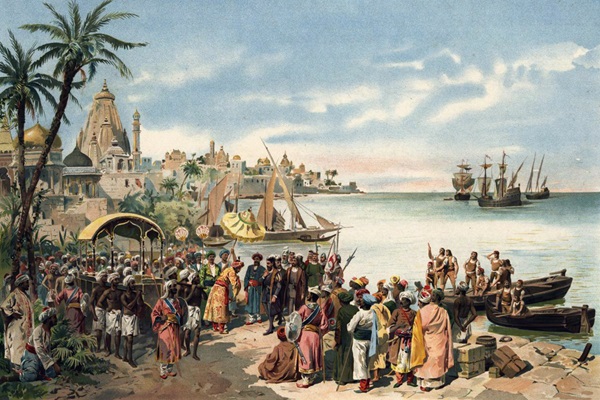.png)
Ottoman Charts, Modern Boycotts And Political Wars
Six centuries after Vasco da Gama pirated Turkish maps, India’s boycott of Ankara’s goods rewrites trade alliances. Geopolitics blurs into diplomacy.


Phynix is a seasoned journalist who revels in playful, unconventional narration, blending quirky storytelling with measured, precise editing. Her work embodies a dual mastery of creative flair and steadfast rigor.
May 18, 2025 at 7:26 AM IST
Dear Insighter,
Let’s go back to 1498, when Vasco da Gama ‘discovered’ India clutching Arab-Ottoman nautical secrets—maps so fiercely guarded, they were the 15th-century equivalent of nuclear codes. Today, history’s spice wars have curdled into a bitter brew after Ankara’s vocal backing of Pakistan post-Operation Sindoor.
The fallout from the Indo-Pak conflict spilled into bazaars and boardrooms. Indian consumers, with the quiet fury of aunties sidelining a troublesome neighbour, began scrubbing Turkish goods from their lives. Turkish apples, once piled high in mandis, now rot in crates as traders pivot to Himachali pears.
But the chill runs deeper than produce. Çelebi Hava Servisi, a Turkish firm that managed ground operations at Delhi and Mumbai airports, had its security clearance abruptly revoked. Meanwhile, wanderlust has wilted: travel platform MakeMyTrip reported a 60% nosedive in bookings to Turkey and Azerbaijan, with cancellations spiking 250%.
As geopolitics continue to simmer, Operation Sindoor, Kalyan Ram notes, marks India’s shift from “retaliation to resolve,” a doctrine forged after Pahalgam’s bloodshed. Yet, Srinath Sridharan dubs Trump’s ceasefire tweets as conflict tourism with a hashtag, underscoring how Ankara’s pro-Pakistan stance fuels Delhi’s ire. As Sridharan writes, “The only meaningful ceasefire is one followed by cessation—not just of gunfire, but of infiltration, radicalisation, and state-sponsored duplicity.” Hope orbits above.
Amid the geopolitical drama, India’s economy hums—but not without hiccups. April’s GST haul hit a record ₹2.1 trillion, and exports rose 9.7%, as BasisPoint Groupthink observes. Yet beneath these headline numbers, rural demand droops like a parched paddy. Inflation’s retreat, however, has turned doves giddy. April’s 3.16% CPI—a six-year low—has Richard Fargose recalculating the terminal repo rate to 5.00%.
But while algorithms adjust forecasts, farmers hedge their bets with little more than prayer. Sanjay Mansabdar laments that India’s agri-futures market, riddled with delivery risks worse than monsoon forecasts, leaves half the workforce hedging hopes instead of prices. When a farmer sells futures, he’s not speculating, he’s surviving, explains Mansabdar.
Meanwhile, the Trump tariffs saga morphs from stunt to stress test. Ajay Srivastava urges Apple CEO Tim Cook to treat Trump’s diktat to shift iPhone assembly to the US not as coercion but as a strategic opening. India’s shallow assembly gains are no substitute for deep reforms in chips, batteries, and displays, he notes, suggesting the reshuffle might eventually nudge India toward more meaningful manufacturing.
But the broader tariff wave, Amitrajeet Batabyal warns, is a Smoot-Hawley redux—raising inflation and job losses while doing little for real manufacturing revival. Michael Spence sees confusion, not clarity, as the defining feature of Trump’s “Liberation Day” policies: tariffs paused, markets rattled, strategy elusive. Daniel Gros highlights the hidden tremors—how Trump’s war may not fix the US current account but will warp global trade flows and strain supply chains.
Nilanjan Banik compares Trump’s logic to Argentina’s lost century—“a flawed fantasy of reciprocal tariffs” that defies economic basics and may boomerang. Manoj Rane calls Trump’s trade retreat all optics, no outcomes, with a hollow UK ‘deal’ passed off as victory while cargo dwindles and inflation looms.
The result: the US economy, caught between posturing and paralysis, now exports more confusion than goods.
Moreover, Trump’s “Most Favoured Nation” drug pricing edict has Dev Chandrasekhar warning that Indian pharma’s 30-60% profit reliance on the US is a time bomb. Ajay Srivastava agrees, urging India to resist patent-law dilution in FTAs: Generics aren’t just business; they’re a moral ledger.
The plot twists in Geneva, where the US and China temporarily sheathe tariffs, a 90-day truce that’s less peace treaty and more intermission. But India’s WTO counterpunch, Ajay Srivastava observes, signals a sharper trade spine: New Delhi won’t haggle over sovereignty.
The market’s recent rally? A sugar rush—from tariff de-escalation, a ceasefire, RBI’s liquidity IV, and selloff fatigue, argues Dhananjay Sinha. He warns this rebound is a respite, not redemption, with ₹43 trillion in household wealth still vapourised.
Meanwhile, corporate sagas unfold. The JSW-Bhushan bankruptcy tussle, Krishnadevan V argues, tests whether India’s insolvency code bends to crony capitalism or crowns the rulebook. Vodafone Idea’s legal gambit, he adds, turns the government into a “49% hostage” to its own bailout. Even Infosys’ AI ambitions, Krishnadevan warns, risk being smothered by legacy code unless spun off like a rebellious princeling.
In another analysis, he explains, TRAI’s satellite policy aims to connect villages, not conquer markets—a nod to inclusion over upheaval.
Six centuries ago, da Gama’s stolen maps reshaped trade; today, India’s boycott of Turkish goods redraws alliances. The Ottomans guarded spice routes, Trump weaponises tariffs, but the lesson remains: control the map, and you control the game. As silk caravans once pivoted to avoid bandits, so must modern trade—nimble, wary, and ever-watchful of who holds the compass.
Until next week — from one who’d take parchment over pixels (but still checks Twitter).
Yours truly,
Phynix
Also Read
- Ending Hostilities: Towards A New Beginning writes Steve Correa: True peace demands dismantling vengeance’s grammar.
- Your Data Is Powering Bad Purchases warns Amitrajeet Batabyal: AI’s manipulation of consumer choices demands data diets, not feasts.
- The Fading Pulse Of A Rules-Based World Order notes Srinath Sridharan: Multilateralism risks becoming a relic, not a remedy.
- Distraction Pays: How Political Power Manipulates The Spotlight writes Steve Correa: Noise drowns truth in the theatre of governance.
- Offscript Weekly: In The Fog Of News, Hope Shines Through notes Ranjana Chauhan: Cautious optimism amid BrahMos missiles and ceasefire theatrics.
- Gensol, Vodafone Idea, New CJI, Foreign Law Firms, And More: Vodafone’s Hail Mary legal plea meets SC déjà vu in this week’s Court Unquote.
- Punctuation Marks by Shyam Sunder Sharma: Sarus cranes trumpet unanswered questions in twilight’s grammar.
- Leo XIV And The Pro-Market Tradition Of The Church writes Michael R. Strain: Can the first American pope redeem capitalism’s soul?



